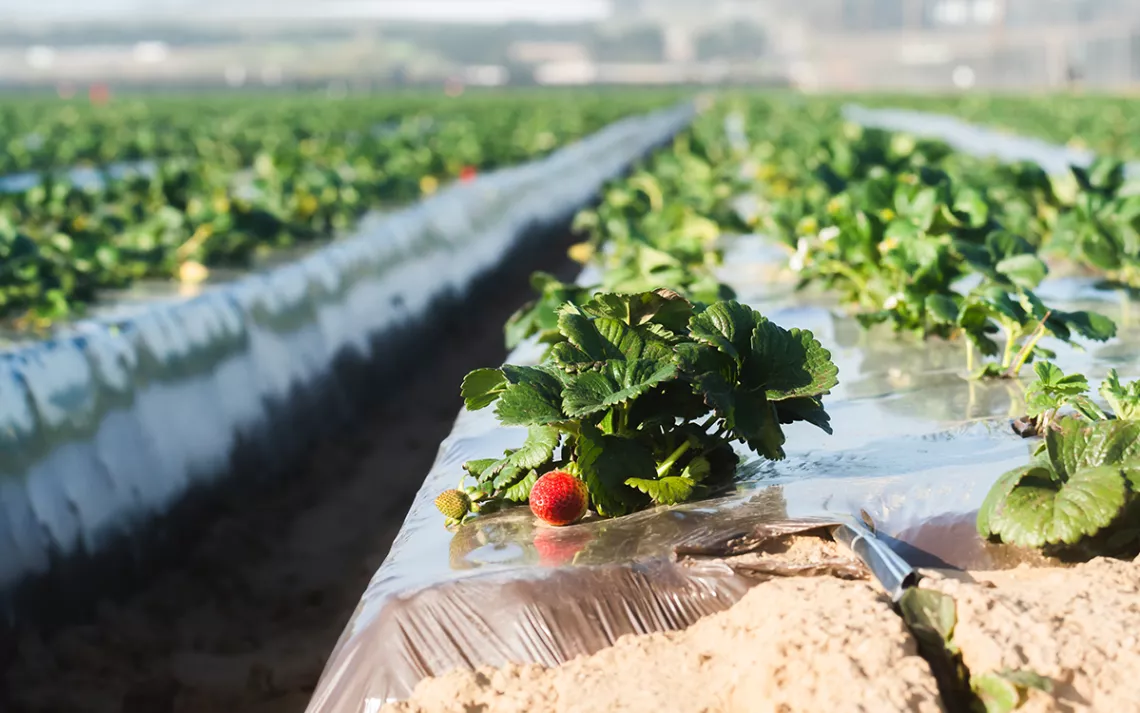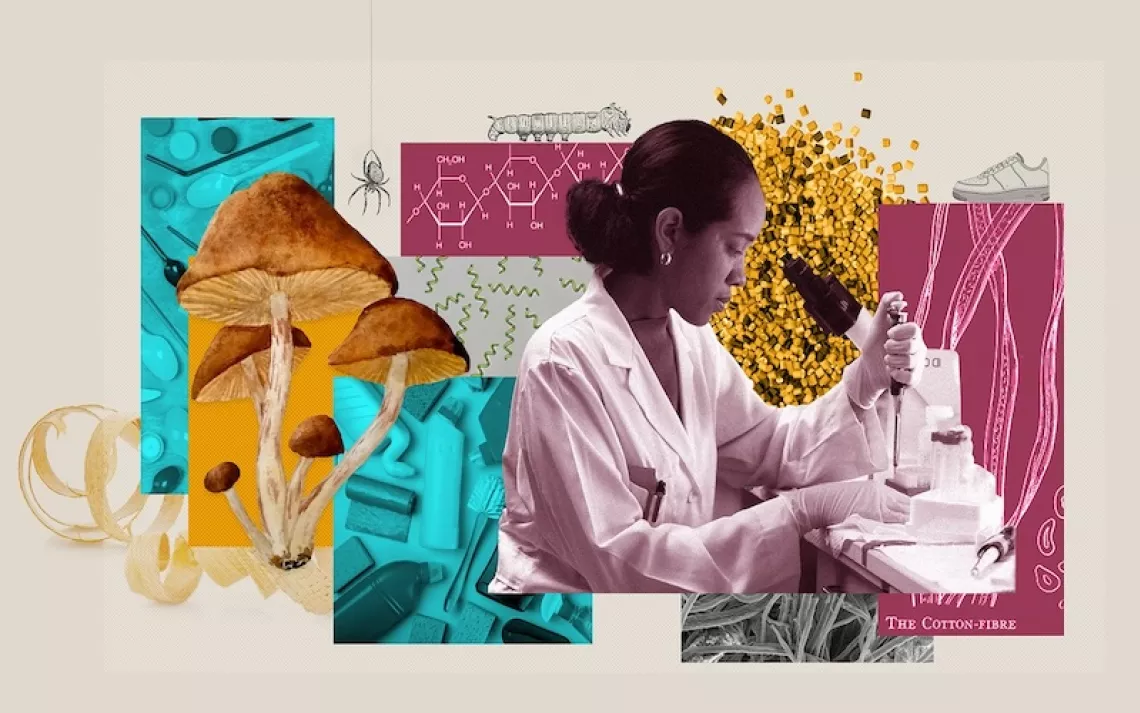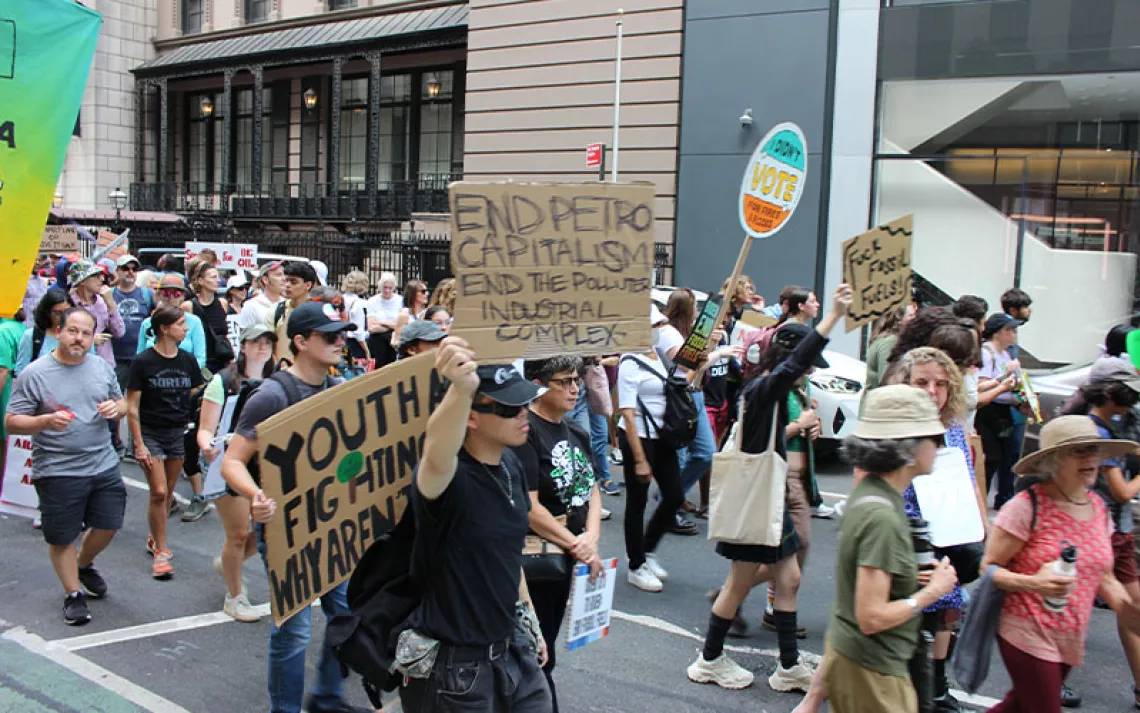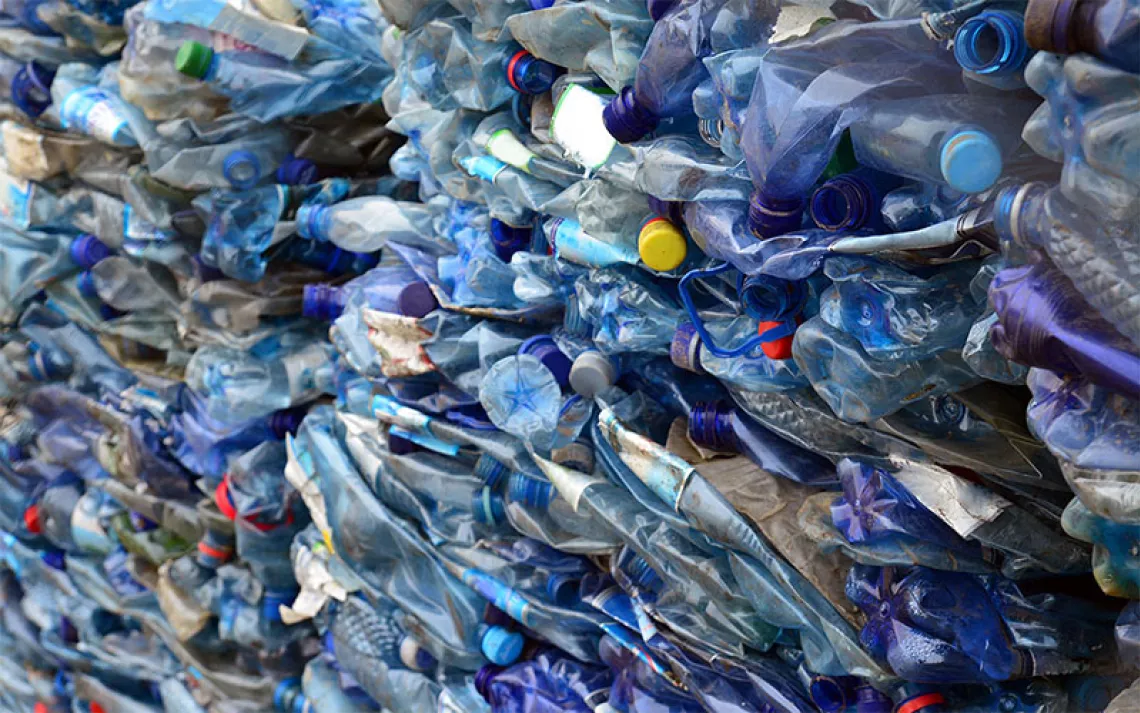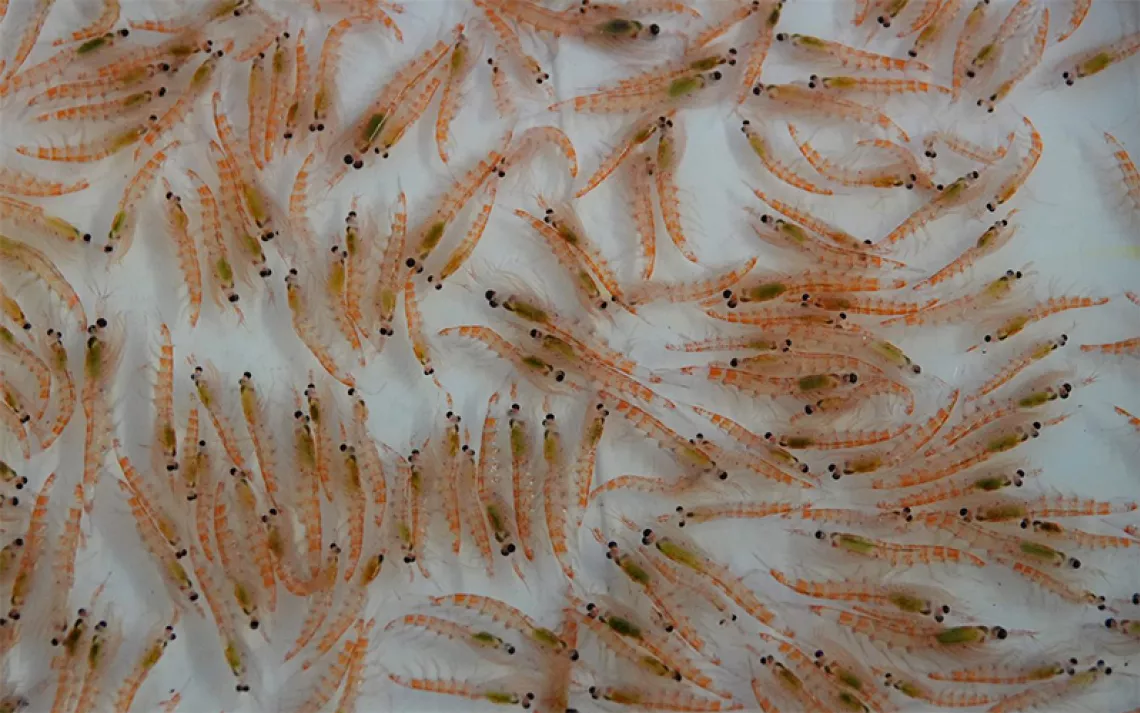The Overlooked Root of Plastic Culture in the Food System
Inside the scope of the plasticulture predicament—and what can be done about it
If you drive along California’s Central Coast, you will see the ocean on one side—and oceans of plastic on the other. This is according to Dr. Seeta Sistla, an assistant professor at California Polytechnic State University (Cal Poly). “It looks like the sea because it’s so many acres of plastic that have been put down,” says Sistla, the primary investigator on two multi-institution research grants studying biodegradable alternatives to plastic mulch in agriculture. “It’s absolutely astounding how much plastic use goes into producing food—plastic that’s then not functionally reusable. And it’s building up in our soils.”
When we consider plastic in the food system, packaging is usually top of mind. It’s the largest source of plastic waste globally, with a widely documented impact, especially in marine environments. But those clear berry clamshells, produce bags, yogurt containers, and Styrofoam meat trays lining grocery store shelves represent the very end of plastic’s journey from field to fork.
Widely used across agriculture and aquaculture sectors—from crops to forestry, livestock, and fishing, in organic, conventional, hydroponic, and soil-centered systems alike—plastic touches everything we eat. That’s because plasticulture—the application of plastics in agriculture—carries numerous benefits. Applied as mulch and weed blockers for produce, cover for fruit trees, and wrapping for hay bales, greenhouse liners, seed trays, slow-release fertilizers, irrigation systems, fishing nets, milking tubes, packing boxes, pesticide containers, and so much more, plastic has been increasingly utilized in agriculture since the 1950s. This versatile material helps boost efficiency and yields, reduce soil runoff, conserve water, deter pests, improve sanitation, preserve feeds, and avoid toxic herbicides, among other functions. It’s also a major source of pollution, one that may be damaging the very lifeblood of our food system: soil.
And consumers are largely unaware that strawberries, tomatoes, salad greens, and other produce are frequently grown in rows fitted with plastic sheeting, that bananas mature in pesticide-impregnated plastic bags, that polymer-coated seeds sprout from agricultural sites across the globe, and that modern fishing plainly wouldn’t exist without plastic.
“Landscapes hide plastic really well. We’ve sampled areas where it looks like there’s nothing there until you get down and look, and then there’s all these visible fragments and who knows how much microplastic,” says Sistla. “Our lab has found that there’s upwards of 10 to over 100,000 pieces of plastic per hectare left behind after clean removal of this material. And this is not because farmers are not being careful. . . . But if you use plastic year in, year out, for 20 years, you see an accumulation, even in really well-managed fields.”
Despite its deep roots, plasticulture is often overlooked in mainstream discussions of sustainable agriculture (largely because of its non-visibility in the public eye), but researchers are increasingly discovering the practice poses real threats to the future of food security.
Late last year the United Nations Food and Agriculture Organization (FAO) issued A Call for Action concerning the long-term impact of plasticulture on terrestrial and aquatic environments and human health. The FAO found that in 2019 alone, 12.5 million tons of plastic products were used in plant and animal production, and another 37.3 million tons were used in food packaging. Most of those plastics are single-use and replaced annually, if not seasonally. Often possessing little recycling value, millions of tons end up in landfills or are incinerated, releasing microplastics into food, fields, air, and water all along the way.
Those plastic particles are known to scale the food web. Now they’re being found in roots and crops, and even making their way into human blood. Studies confirm that microplastic is altering soil composition too, disturbing the relationship between soil microbes—organisms essential to healthy earth and nutritious foods—along with soil’s ability to absorb water. That’s particularly alarming, given that scientists estimate agricultural soils may contain more microplastics than the oceans.
With over 90 percent of global agriculture taking place on land, finding alternatives to plastics in crop production is critical.
Reducing Dependence and Increasing Alternatives
Dr. Gladis Zinati, director of the Vegetable Systems Trial at Rodale Institute—a long-term study comparing vegetables grown in organic and conventional cropping systems side by side with various management practices—aims to link soil health, plant health, and nutrient density to human health. The trial, which began in 2016, implements intensive tillage with black plastic mulch and reduced tillage without plastic for both its conventional and organically grown crops.
Black plastic mulch is standard in organic and conventional farming practices; it’s used to control weeds, expedite production, and reduce tillage, herbicides, and labor. The FAO confirms that plastic films (such as mulches, greenhouse films, and silage wraps) represent 60 percent of all plasticulture. Despite their ubiquity, such plastics are difficult to recycle because of contamination from plant, soil, and pesticide residues.
One way that farmers can get around this is by growing cover crops and using roller crimpers (a tractor attachment invented by Rodale that lays said crops onto the field, creating a dense carpet where sowed seeds flourish and weeds perish). The cropping method can supplant the use of over 90 pounds of plastic per acre. It’s also improving soil health. So far, the Vegetable Systems Trial has shown that both bacterial and fungal biomass (crucial microorganisms responsible for decomposing crop residues and building soil organic matter) are greater in the organic reduced-tillage beds—those that employ cover cropping and roller crimping instead of plastic. Zinati notes another important finding: These valuable soil generators weren’t just fewer in the plasticulture beds; their activity was also ultimately reduced by the hot environment created by the black plastic.
While the cropping system has obvious benefits, it may not be a fit for all operations. Straw, wood chips, paper, and even wool all provide additional substitutes to plastic mulch. Flame weeders are another long-standing tool, and Rodale is working on an electric weed zapper to snuff unwanted growth on vegetable fields. Zinati also recommends rotating crops to help build healthy soil and planting crops that grow quickly to outcompete weeds.
Biodegradable mulch (BDM) is yet another option, though it’s more costly and somewhat controversial. Sistla and her colleagues are working to better understand the viability of BDMs as a replacement for conventional polyethylene plastic, their use and utility in the field, and their impact on soil and crops.
“There are no deleterious effects that we can detect of using BDM on yield, or of the strawberries or quality of the strawberries,” says Sistla, whose research centers on the popular fruit. “So it seems like the BDM works well in the field. It’s extremely durable as well. The thicker BDMs, they’re not breaking down; they’re not falling apart during the growing season.”
While BDMs appear promising, Sistla is careful to make clear that “there’s no free lunch, even in the biodegradable world.” Language in this field can be confusing. “Just because it’s biodegradable doesn’t mean it's biologically derived,” she clarifies. Such mulches can be biobased (using natural materials like starch or cellulose), made from fossil fuels, or a mixture of the two, she notes. To be considered truly biodegradable by ASTM International, BDMs must be 90 percent mineralized or transformed into carbon dioxide under composting conditions within 180 days. If a mulch doesn’t meet that standard, it won’t break down effectively in fields, and if visible fragments are left behind, farmers won’t want to use it, Sistla explains.
Another barrier to adoption? BDMs are unusable on certified organic farms because the technology remains unable to meet the National Organic Program standards, which require BDMs to be 100 percent biobased, non-GMO, and compostable, and 90 percent biodegraded in soil within two years of application.
“There are benefits, but there are lots of disadvantages,” says Zinati, who remains concerned about the documented adverse effects of biodegradable plastics on soil. “These could impact the microbes. They can impact the soil structure, and the physical properties, and the chemistry.” That could lead to microorganisms spending more energy decomposing BDMs than providing plants with vital nutrients. As with conventional plastics, pollutants could leach from particles left behind, and the accelerated decomposition of BDMs could result in more littered soils, Zinati cautions. “Researchers have to do more in-depth work to trace and monitor the degradation of those biodegradable plastics and how they end up in the soil as well as in the harvestable crop.”
Sistla agrees that more research is needed to understand the long-term effects of biodegradable mulch on soil, crops, and human health—goals that constitute the essence of her studies. “We need to know more about how quickly these materials decompose in the field and whether they do have any effects on crop production,” says Sistla, adding that “if the feedstocks can be refined to be sustainable, biobased, . . . it could be really, really promising.”
While US farmers have been slower to adopt BDMs, the material is more commonly used in other parts of the world, notably Europe, where the European Committee for Standardization has developed standards around the use of biodegradable plastic and banned the use of OXO-degradable plastics, given their significant environmental risks, including increased microplastic pollution.
Further research, innovations, and regulations are needed for all agricultural plastics, including biodegradable and compostable substitutes, to safeguard essential soil and water systems for a growing population amid a changing climate, conditions under which plasticulture is only expected to increase.
Making a Difference: Promoting Visibility in a Complex Food Chain
Thaddeus Barsotti, a second-generation organic farmer and the co-owner of Capay Organic, a 350-acre certified organic farm in Yolo County, California, selling fruits, vegetables, and some commodity crops, says plastic hasn’t increased all that much on his farm since it was founded in 1976, despite the global trend. Today the largest source is drip tape, a common irrigation tool that is particularly useful in arid climates. The farm replaces drip tape seasonally, as crops turn over, and recycles the material with the manufacturer, which provides on-farm pickup. “But when you move closer to the customer and away from the field,” says Barsotti, “you see a lot more plastics.” This is something he’s actively working to change.
Though the farm sells both retail and directly to consumers via farmers’ markets and Farm Fresh to You (a CSA delivering approximately 20,000 boxes of food to subscribers per week), 95 percent of Capay Organic’s produce is found in grocery stores. “Unfortunately, even though consumers might say that they want plastic-free items, it’s hard to pull that through the whole food chain,” he explains, citing that reduction has been a challenge with his supermarket clients.
Barsotti is working to minimize plastic packaging by switching from plastic bib ties to paper and metal twist ties for bunched greens, swapping out plastic baskets for cardboard pints for cherry tomatoes, embracing biodegradable bags, and reducing plastic bag use in general through Farm Fresh to You. But “[wholesale] buyers don’t look at our product and give it any more value because it doesn’t have plastic,” he says. “In fact, I’ve heard the contrary: ‘Love your product. Needs to be in a two-pound plastic bag, or I can’t sell it.’ And that’s just the reality.”
“Right now we’re in a system where it is the norm,” says Sistla. “And there’s good reasons for it from a grower perspective. But if consumers were willing to pay twice as much for their berries if they weren’t growing with any plastic at all, that would be interesting to see.”
Though that may sound like a steep price tag, both Barsotti and Sistla highlight the importance of considering the economic externalities of plastic. “This is having a real cost to our society, but it’s not having an economic cost, so it’s getting ignored in our system,” says Barsotti. “It’s even being encouraged because the economic benefits of using plastic are so great.”
Farmers and fishers can continue to move the needle on plastic reduction by making small changes that add up, like swapping plastic pots for cardboard, plastic harvest bags and Styrofoam fish boxes for reusable crates, and greenhouse films for glass and polycarbonate.
The FAO finds that action is also needed by business and policymakers in the form of improved product recyclability and broader access to recycling infrastructure; development of extended producer responsibility programs, in which companies are accountable for their products’ waste; investment in alternative materials, equipment, and systems approaches; product certifications and standards; and legislation, both nationally and internationally, including product and material bans. Global guidelines, incentives, and enforcement would also go a long way to reduce, reuse, and recycle agri-food plastics.
Widespread consumer awareness of plastic’s true presence in food production will be fundamental to making waves too. Individuals can take it further by supporting local farmers and fishers through farmers' markets and CSAs, discussing their concerns with growers, self-educating, and advocating for meaningful corporate, social, and governmental changes. The future of food depends on it.
 The Magazine of The Sierra Club
The Magazine of The Sierra Club
